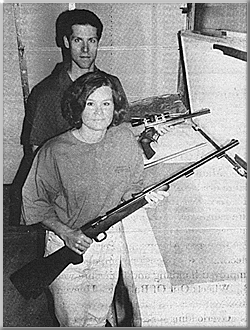  Cryogenics provides big chill, hot guns
Cryogenics provides big chill, hot gunsby Natalie Weisiger Baraboo Sun As appeared in the Baraboo Sun, August 12, 1998. With hunting season just around the corner, it's time to get all the necessities ready. But what if you could shoot twice as many rounds, hit more accurately than ever before and clean your gun in minutes? You'd probably think it wasn't possible, but with a new process called Coldshot, all these claims can come true. The local business Badger Cryogenics and Heat Treating, Inc. offers Coldshot, which is the cryogenic treatment of gun barrels. Now when most people hear the word cryogenics, they think of freezing bull semen, heads or bodies, but Renee and Adam Weitzel, owners of Badger Cryogenics and Heat Treating, Inc., only freeze inanimate objects. Besides freezing industrial tools, which is the core of their business, the Weitzel's also gear toward hunters, law enforcement officers and competition shooters. Cryogenics is very beneficial for any and all firearm owners for many reasons. One problem gun owners face is the stresses that cause a barrel to bend or warp as it heats from repeated firing. Because of this warping, there is a stringing, walking or wandering effect in the shot group. After the cryogenic process, the barrel will no longer bend or warp. The end result is a firearm barrel with increased performance, improved accuracy and extended barrel life. Commercial deep cryogenic treatments first became available in the United States in 1965. Since that time many studies and tests have proven that cryogenic treatment will result in the permanent volumetric enhancement of metal properties.
First, items are covered with gun oil to protect them from any moisture exposure. The objects are placed in the freezer, which is 5 ½ feet long, 1 ½ feet wide and two feet high on the inside. Once the barrels are inside the freezer, the temperature is slowly lowered to minus 300 degrees with liquid nitrogen tanks located behind the freezer. The temperature is computer profiled-controlled to within 1/10th of one degree Fahrenheit throughout the complete cycle. It takes about one minute for each degree the temperature drops inside the freezer. Firearm barrels are then held at minus 300 degrees for up to 24 hours, and then the temperature is slowly raised. The barrels are then heated to plus 300 degrees Fahrenheit before slowly returning to room temperature. Scientific Results Coldshot is a dry process that unlike other deep cryogenic processes does not bath the materials in liquid nitrogen. Slowly cooling a gun barrel to deep cryogenic temperatures and soaking it at this low temperature for several hours changes the material's microstructure. Almost all of the austenite (a soft form of iron) retained in the steel after heat treating is transformed into a harder form known as martensite. A second result of a deep cryogenic "soak" is the formation of fine carbide particles, called binders to complement the larger carbide particles present before cryogenic treatment. Because the Coldshot permanently refines the grain structure of a firearm barrel at the molecular level, it produces a homogeneously stabilized barrel. -300 degrees Adam, who has an extensive background in firearms and an associates degree in gunsmithing, explains the cryogenic process in simple terms. "As the metal is slowly cooled down, the molecules get closer and closer together," said Adam. The barrels are then held at -300 degrees for a predetermined amount of time and then slowly warmed back up. "Now the molecules begin to come apart, but instead of coming apart unevenly like they once were, they come apart even and equal distances from each other," explained Adam. Because the molecules are more evenly distributed, the gun barrel is more homogenous. With the grain structure closer and tighter, there is a reduced friction because there is not such a gagged or rough surface. When a hard asperity or foreign particle is pressed onto the tool's surface, the carbides further resist wear by preventing the particle form plowing into the surface. "After the Coldshot process, instead of the bullet going through a surface that like sandpaper, it's going through a smooth surface like a piece of glass," said Adam. A recent customer who had his new 260 Remington target barrel cryoed at Badger Cryogenics and Heat Treating, Inc. had wonderful results. "The bullet size is .260, and he was getting groups as tight as .278," said Adam. "That's five bullets going through a hole that is just a little bit bigger than the bullet itself." Good for the gun Because there is less wear and residue, the barrel lasts longer and greatly increases performance. Not only does the freezing process have great benefits, it's also very gentle for the gun. "We've put light bulbs through that didn't shatter or break," said Renee. "That's how slow and gentle the process is." Some people may be reluctant to freeze their guns to minus 300 degrees, but there is evidence to show that not only is it gentle, but it works. The basic mechanisms at work during the cryogenic process help control wear by producing a tough surface which helps to prevent particles from tearing out of the material and resist penetration of the surface by other particles. Ralph Kosch from Four Seasons Sport Center in LaValle describes his results after using Coldshot on his Remington 700-22-250. "I've had several guns treated, and I am really pleased with the results," said Ralph. "After getting my Remington cryoed, I shot 400 rounds in one day. The gun held its accuracy and it took less than 10 minutes to clean. This process is very impressive!"
Dick Roterud had this to say: |

Home | Coldshot Firearms | Automotive/Engine | Recreational Uses
For more information, please contact us at (608)524-8600.
Fax us at (608)524-8699 or Email bcryo@merr.com. Thank you.